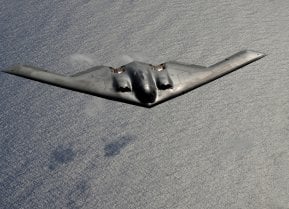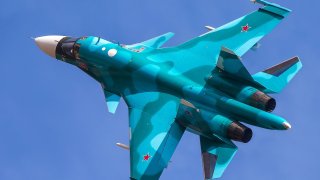Su-54: The 'Trainer' Fighter Russia Never Built
Even after the Su-54 fell through, Sukhoi attempted to offer Su-55 and Su-56 for export to India and South Africa in the 1990s, but to no avail. One final attempt to revive the concept in the early 2000s also fell through.
Pity the poor Sukhoi Company of Russia, which has been folded into the United Aircraft Corporation. Life as a Sukhoi/UAC senior executive is embarrassing enough in light of the highly publicized shootdowns of the company’s much-vaunted Su-34 “Fullback” fighter-bomber and Su-35 “Flanker-E” air superiority fighter in the skies over Ukraine. But history shows that Sukhoi’s misfortunes and disappointments date back a few decades. Their frustrations even carried over to mere training aircraft, far away from the battlefield.
Say hello to the Su-54 trainer, a short-lived design concept that ended up never being built and therefore never even earned a catchy NATO reporting name.
Late Cold War Origins
The concept of the Su-54 traces its origins to 1990, the year before the collapse of the Soviet Union. At the time, Warsaw Pact countries were using the Czechoslovakian-made Aero Vodochody L-39 Albatros and L-29 Delfin as their primary jet trainers. These jets debuted in 1968, and they were nearing the end of their service lives. Ever mindful that a more modern platform was needed to provide trainee pilots their last baby steps before transitioning onto advanced fourth-generation fighter jets, the commander in chief of the Soviet Air Force issued a request for the design of a new advanced jet trainer.
Fast-forward to 1993, two years after the Soviet collapse, and the Yakovlev Yak-130 “Mitten” ended up beating out the Su-54 as the winning proposal. (Note, it earned a NATO codename). The Mitten remains the Russian air force’s jet trainer.
Post-Cold War Fiscal Fizzle
It wasn’t that the Su-54 was necessarily a bad design. It was simple economic realities that kept it grounded. Due to the dire straits of the early post-Soviet Russian economy, it became clear that the trainer contract had to be given to one of the smaller design bureaus, as Sukhoi and Mikoyan were already building Su-27 “Flankers” and MiG-29 “Fulcrums,” respectively – the country's top-of-the-line fourth-generation fighter jets at that time.
As Aerotime Hub columnist Valius Venckunas writes:
“That situation was also reflected in four trainer designs that were offered. All of them were focused on being as cheap as possible, using previous research and elements of other aircraft, as well as making an emphasis of aircraft’s adaptability for various missions and purposes…Sukhoi’s design took both of those ideas the farthest…So, Sukhoi came up with three versions for its new airplane. The S-54 would be an advanced trainer; the S-55 would be a light fighter intended to supplement the heavier ones, and the S-56 would be its carrier-borne variant…All of them were scaled-down versions of the Su-27 platform, both visually and functionally…[T]o the naked eye, the result speaks for itself: the new aircraft looked exactly like a small Flanker.”
Su-54: Specifications
Had the Su-54 actually ended up being built – and indeed held true to the original proposal – it would have sported a fuselage length of 12.3 meters and a wingspan of 9.8 meters – just over half of the Su-27’s dimensions. Even more impressive, the little jet would’ve weighed in at 4,200 kg while empty, which amounts to barely more than one-fourth the empty weight of the Flanker.
In other words, had the Su-54 been built, it would have become the smallest and lightest modern fighter jet, being on par with Korean War-era aircraft such as the MiG-15 “Fagot” and the F-86 “Sabre.” Venckunas provides some additional perspective on the compactness and light weight of the design: “Light fighter jets of the fourth generation – such as the F-16, the MiG-29 and the HAL Tejas – were all substantially bulkier, and even previous-generation designs, such as the F-5 and the MiG-21, were heavier by several hundreds of kilograms,” he writes.
Max airspeed would have been a respectable Mach-1.5, and the aircraft would have had a maximum range of 2,000 km. Perhaps most impressively, the baby jet’s Saturn AL-31 engine would have provided half of Su-27’s thrust for just one-fourth of its weight, making its thrust-to-weight ratio unmatched.
Su-54: What Might Have Been
Even after the Su-54 fell through, Sukhoi attempted to offer Su-55 and Su-56 for export to India and South Africa in the 1990s, but to no avail. One final attempt to revive the concept in the early 2000s also fell through.
As Venckunas concludes on a humorous note, “Anyway, at least one result of the S-54 program is undeniable: it resulted in, possibly, the cutest fighter jet ever. Of course, the combat potential of this feature is up for a debate.”
Christian D. Orr is a former Air Force Security Forces officer, Federal law enforcement officer, and private military contractor (with assignments worked in Iraq, the United Arab Emirates, Kosovo, Japan, Germany, and the Pentagon). Chris holds a B.A. in International Relations from the University of Southern California (USC) and an M.A. in Intelligence Studies (concentration in Terrorism Studies) from American Military University (AMU). He has also been published in The Daily Torch and The Journal of Intelligence and Cyber Security. Last but not least, he is a Companion of the Order of the Naval Order of the United States (NOUS).
Note: As the plane was never built, we used a Su-34 image.


